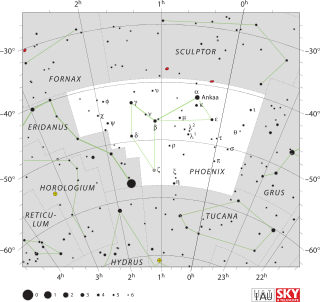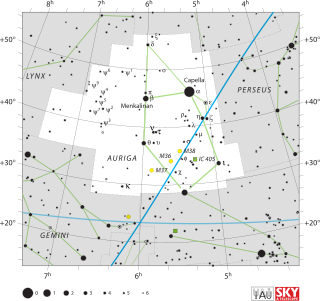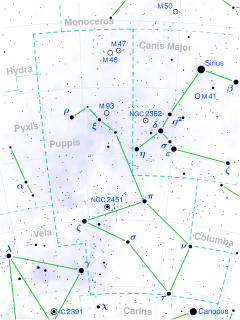Basic information

- Abbreviation: TCE
- Speed: 60 km/s
- Rating: Weak
- Hourly rate: 4
- Peak Date: February 14
- Radiant: Alpha= 210 degrees, Delta= -40 degrees
Theta Centaurids is a weak meteor shower that occurs from January 23 to March 12. It is only visible from the Southern Hemisphere.

Theta Centaurids is the northernmost of several meteor showers. The radiant is located west of Lupus. Theta Centaurids is best seen at five o’clock in the morning and eleven o’clock at night. This shower occurs as little as one day after Alpha Centaurids, a meteor shower around the same area. Another meteor shower nearby is the Omicron Centaurids shower. Theta Centaurids is considered a very fast meteor shower. Its range is -9, +40. It has 14:00 for a right ascension, and a declination of -41 (Right ascension and declination are like latitude and longitude for astronomy). This meteor shower badly needs a thorough scientific study.

Boötes is a constellation in the northern sky, located between 0° and +60° declination, and 13 and 16 hours of right ascension on the celestial sphere. The name comes from Latin Boōtēs, which comes from Greek Βοώτης Boṓtēs 'herdsman' or 'plowman'.

Right ascension is the angular distance of a particular point measured eastward along the celestial equator from the Sun at the March equinox to the point in question above the earth. When paired with declination, these astronomical coordinates specify the location of a point on the celestial sphere in the equatorial coordinate system.

Astronomical coordinate systems are organized arrangements for specifying positions of satellites, planets, stars, galaxies, and other celestial objects relative to physical reference points available to a situated observer. Coordinate systems in astronomy can specify an object's position in three-dimensional space or plot merely its direction on a celestial sphere, if the object's distance is unknown or trivial.

Phoenix is a minor constellation in the southern sky. Named after the mythical phoenix, it was first depicted on a celestial atlas by Johann Bayer in his 1603 Uranometria. The French explorer and astronomer Nicolas Louis de Lacaille charted the brighter stars and gave their Bayer designations in 1756. The constellation stretches from roughly −39° to −57° declination, and from 23.5h to 2.5h of right ascension. The constellations Phoenix, Grus, Pavo and Tucana, are known as the Southern Birds.

A meteor shower is a celestial event in which a number of meteors are observed to radiate, or originate, from one point in the night sky. These meteors are caused by streams of cosmic debris called meteoroids entering Earth's atmosphere at extremely high speeds on parallel trajectories. Most meteors are smaller than a grain of sand, so almost all of them disintegrate and never hit the Earth's surface. Very intense or unusual meteor showers are known as meteor outbursts and meteor storms, which produce at least 1,000 meteors an hour, most notably from the Leonids. The Meteor Data Centre lists over 900 suspected meteor showers of which about 100 are well established. Several organizations point to viewing opportunities on the Internet. NASA maintains a daily map of active meteor showers.

Auriga is one of the 88 modern constellations; it was among the 48 constellations listed by the 2nd-century astronomer Ptolemy. It is north of the celestial equator. Its name is Latin for '(the) charioteer', associating it with various mythological beings, including Erichthonius and Myrtilus. Auriga is most prominent during winter evenings in the northern Hemisphere, as are five other constellations that have stars in the Winter Hexagon asterism. Because of its northern declination, Auriga is only visible in its entirety as far south as -34°; for observers farther south it lies partially or fully below the horizon. A large constellation, with an area of 657 square degrees, it is half the size of the largest, Hydra.
The Quadrantids (QUA) are a meteor shower that peaks in early January and whose radiant lies in the constellation Boötes. The zenithal hourly rate (ZHR) of this shower can be as high as that of two other reliably rich meteor showers, the Perseids in August and the Geminids in December, yet Quadrantid meteors are not seen as often as those of the two other showers because the time frame of the peak is exceedingly narrow, sometimes lasting only hours. Moreover, the meteors are quite faint, with mean apparent magnitudes between 3.0 and 6.0).

Circinus is a small, faint constellation in the southern sky, first defined in 1756 by the French astronomer Nicolas-Louis de Lacaille. Its name is Latin for compass, referring to the drafting tool used for drawing circles. Its brightest star is Alpha Circini, with an apparent magnitude of 3.19. Slightly variable, it is the brightest rapidly oscillating Ap star in the night sky. AX Circini is a Cepheid variable visible with the unaided eye, and BX Circini is a faint star thought to have been formed from the merger of two white dwarfs. Two sun-like stars have planetary systems: HD 134060 has two small planets, and HD 129445 has a Jupiter-like planet. Supernova SN 185 appeared in Circinus in 185 AD and was recorded by Chinese observers. Two novae have been observed more recently, in the 20th century.

The pi Puppids are a meteor shower associated with the comet 26P/Grigg-Skjellerup.
The Beta Taurids (β–Taurids) are an annual meteor shower belonging to a class of "daytime showers" that peak after sunrise. The Beta Taurids are best observed by radar and radio-echo techniques.
Angular distance is the angle between the two sightlines, or between two point objects as viewed from an observer.

The meteor shower of the July Pegasids occurs between the 7 and 13 July. It is a weak meteor shower that has its maximum around July 9 having a ZHR of only 3 meteors per hour. The meteors have, however, an atmosphere entry speed of about 70 km/s.

The radiant or apparent radiant of a meteor shower is the celestial point in the sky from which the paths of meteors appear to originate. The Perseids, for example, are meteors which appear to come from a point within the constellation of Perseus.
The Omicron Centaurids meteor shower has a radiant which is in the constellation Centaurus which is visible from the southern hemisphere. It is most easily seen at 2:00 am, local standard time. It is visible from late January through February each year. It peaks in mid-February.
The Orionids meteor shower, often shortened to the Orionids, is the most prolific meteor shower associated with Halley's Comet. The Orionids are so-called because the point they appear to come from, called the radiant, lies in the constellation Orion, but they can be seen over a large area of the sky. The Orionids are an annual meteor shower which last approximately one week in late October. In some years, meteors may occur at rates of 50–70 per hour.

The Andromedids meteor shower is associated with Biela's Comet, the showers occurring as Earth passes through old streams left by the comet's tail. The comet was observed to have broken up by 1846; further drift of the pieces by 1852 suggested the moment of breakup was in either 1842 or early 1843, when the comet was near Jupiter. The breakup led to particularly spectacular showers in subsequent cycles.
The Virginids are a meteor shower. There are many major and minor meteor shower streams that occur during the Virginid Complex, including the Alpha Virginids, Gamma Virginids, Eta Virginids, Theta Virginids, Iota Virginids, Lambda Virginids, Mu Virginids, Pi Virginids, and Psi Virginids, and March Virginids, emanating mostly from the constellation Virgo between February and May. Collectively, the shower normally lasts from late January to mid-April and into early May, peaking in March and April, with one to two meteors per hour on average. The main radiant shifts southeastwards from central Leo in late January to central Virgo near Spica in mid-May.

The Tau Herculids are a meteor shower that when discovered in 1930 appeared to originate from the star Tau Herculis. The parent comet of the Tau Herculids is periodic comet Schwassmann-Wachmann 3 with a 5.4 year orbital period. This meteor shower occurs from May 19 - June 19. The meteor shower was first observed by the Kwasan Observatory in Kyoto, Japan in May 1930. The Tau Herculids' average radiant was α=236°, δ=+41°. Due to orbital perturbations of the meteor streams by Jupiter, 2022 activity will have a radiant of R.A. = 13:56 (209), Decl. = +28. The meteors are relatively slow moving making atmospheric entry at around 16 km/s (36,000 mph).

The Zeta Perseids (ζ–Perseids) are a daylight meteor shower that takes place from about May 20 to July 5. On the peak date of June 13, the radiant is only 16 degrees from the Sun. The shower was discovered at Jodrell Bank Observatory in 1947 using radio equipment. The Zeta Perseids and Beta Taurids are both probably associated with the Taurid Complex of meteor showers. The Arietids and Zeta Perseids maxima tend to blend into one another.